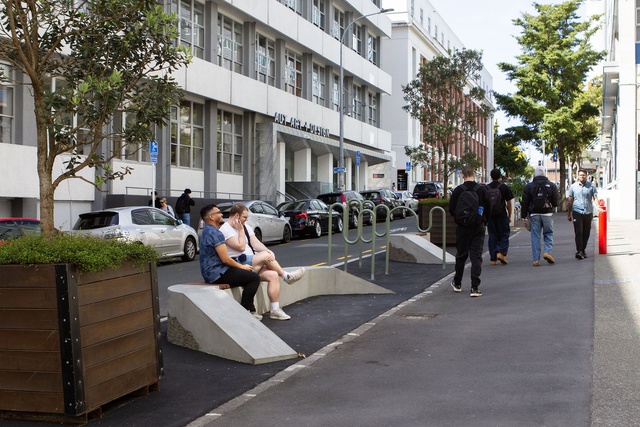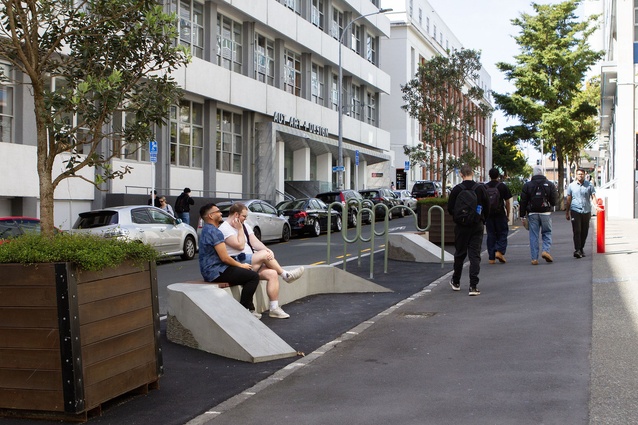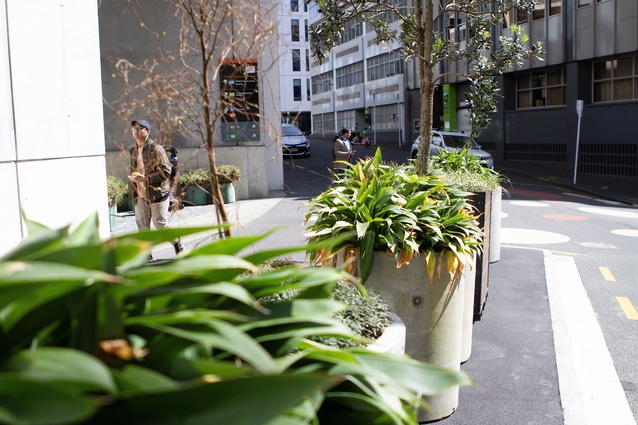Design students get creative alongside their campus
Auckland Council’s Tāmaki Makaurau Design Ope has teamed up with students from AUT and the University of Auckland to reinvigorate surrounding central city streets with a student design lens.
In the first of two semi-permanent street upgrades enabled by Auckland Council, students at AUT were given the opportunity to influence the renewal of a street in their own neighbourhood.
The redesign of St Paul Street in the city centre’s learning quarter by AUT spatial design students from the Master of Design programme Jessica Juno, Leah Van Wyk and Emma Choi is now in place.
Last year, Auckland Council’s Tāmaki Makaurau Design Ope (TMDO) joined forces with the Material Imaginaries Research Collective at AUT, tasking students to “collaboratively develop a concept design for a new St Paul Street installation, replacing the existing equipment.”
Initial research highlighted how students and staff used the street and what activities needed to be provided for and this month, council contractors delivered the group’s innovative, semi-permanent solution, keeping the scope and budget to a ‘no dig’, low disruption execution.
Waitematā Local Board Chair Genevieve Sage says she’s pleased to see Auckland’s next generation of urban designers help shape their university environments.

“It means we’re creating uni neighbourhoods that better reflect the everyday needs of students and staff, and we’re also giving future spatial designers and planners real world experience as they begin their careers,” says Sage.
The students’ design for St Paul Street is anchored by two main elements: a ‘wandering line’ and a series of bench seats. “The wandering line echoes the line of the Rangipuke ridge meeting the upper stream of Te Waihorotiu, re-enacting the slow pooling motion of waterways that were once present in the area,” explains TMDO Principal – Urban Design, Claire Davis. “The concrete benches rise and fall in wave-like forms.”
“Working on a live, quick-response project in collaboration with Auckland Council was a great way to ground our research students’ practice-based inquiries,” says Dr Carl Douglas, Head of Department at AUT.
Participating AUT student Emma Choi said taking part in the St Paul Street project was an invaluable experience. “The project provided opportunities to collaborate with various real-life professionals,” says Choi, “and as one of the main users of St Paul Street, I enjoyed contributing to the street’s vision to become a more pedestrian-friendly place.”
In a second design school partnership, a group of third-year planning students from the University of Auckland are working on concepts for the renewal of Alfred Street.
Here, Auckland Council’s TMDO design team has collaborated with the Architecture & Planning School at the University of Auckland to build a concept for the next phase of the Alfred Street project, replacing the temporary plastic planters.
“The brief was to create a medium-term, people-focused, healthy and biodiverse streetscape while delivering a lighter, quicker, cheaper execution,” explains Davis.
In April, 12 student groups presented their concept designs to a panel of teaching staff and Auckland Council guest critics. The TMDO plans to review the student presentations and consolidate them into one streetscape design to be taken forward through detailed design and implementation.
University of Auckland Associate Director of Design Zoe Avery says the University’s students have found the project enlightening and enjoyable. “It’s fantastic for the students to get to work on a real-world solution and work with not only creativity but also constraints. I hope that we can continue this collaboration further.”












